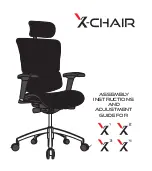
1:
Using a level, locate any
uneven wall areas where the
cabinet will be installed.
Unevenness can cause the
cabinet to become misaligned
resulting in twisting of the cabinet.
Repair any uneven areas.
2:
Determine the desired
location of the cabinet. It is
recommended that the cabinet
be installed to at least 1 wall
stud. In order to locate wall studs,
you can use a stud finder or tap
along the wall until you find a spot
that sounds solid. If you are
unable to locate a wall stud, it is
recommended that you use wall
anchors (B - not included) to
secure your cabinet.
3:
Secure the cabinet to the wall by
inserting (x 4) 2” screws with (x 4)
washers through the backrails of the
cabinet and into the wall.
4:
Attach the hardware (sold separately) as per the instructions provided with the hardware.
INSTALLATION -
for surface-mount (figures 3 and 4)
Figure 3
Figure 4 - Installed
TROUBLESHOOTING
Possible Cause:
Mounting screws are not level.
Wall is not level.
Corrective Action:
Remove the cabinet from the wall and
check the mounting screws. Adjust as
needed.
Adjust the door hinges. Figure 5.
Problem:
Cabinet is higher on one side than the
other.
1) Cabinet doors rub against another
surface.
2) There is a large uneven gap between
the cabinet doors and cabinet.
Side adjustment:
Using a Phillips screwdriver, rotate screw (1)
clockwise to move the door left and
counter-clockwise to move the door right.
Moves the door up to 2 mm.
Depth adjustment:
Using a Phillips screwdriver, rotate screw (2)
clockwise to move the door forward and counter-
clockwise to move the door backwards.
Moves the door up to 2 mm.
Height adjustment:
Using a Phillips screwdriver, rotate screw
(3) clockwise to move the door upward and
counter-clockwise to move the door
downward. Moves the door up to 2 mm.
Figure 5 - Adjusting Hinges
B






















